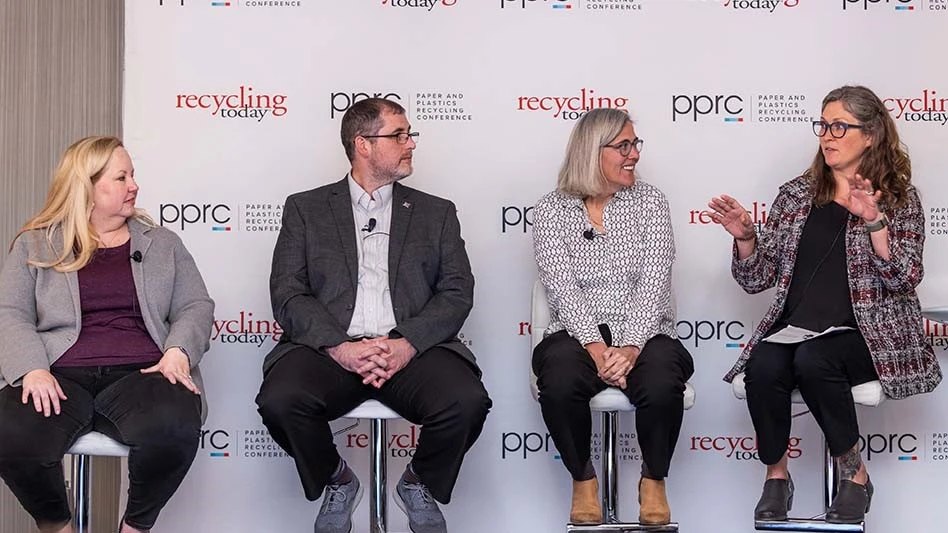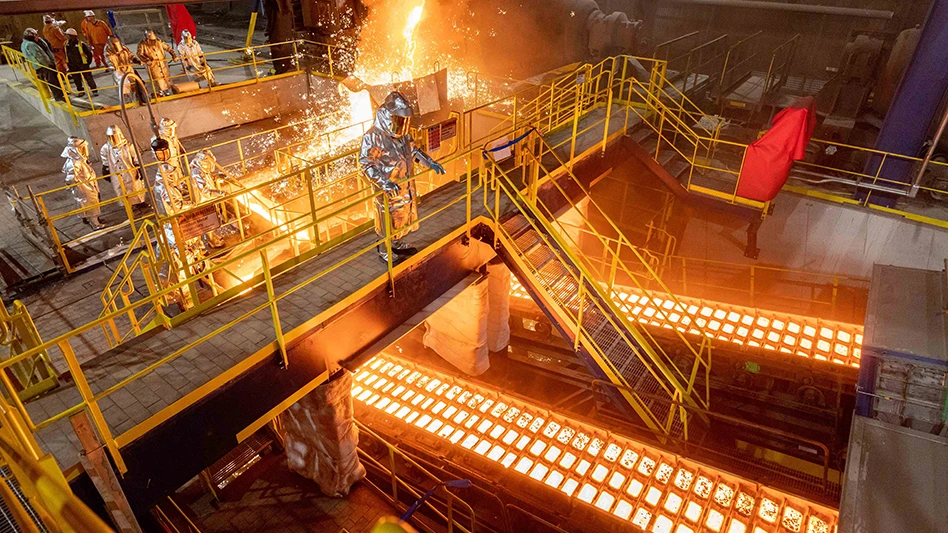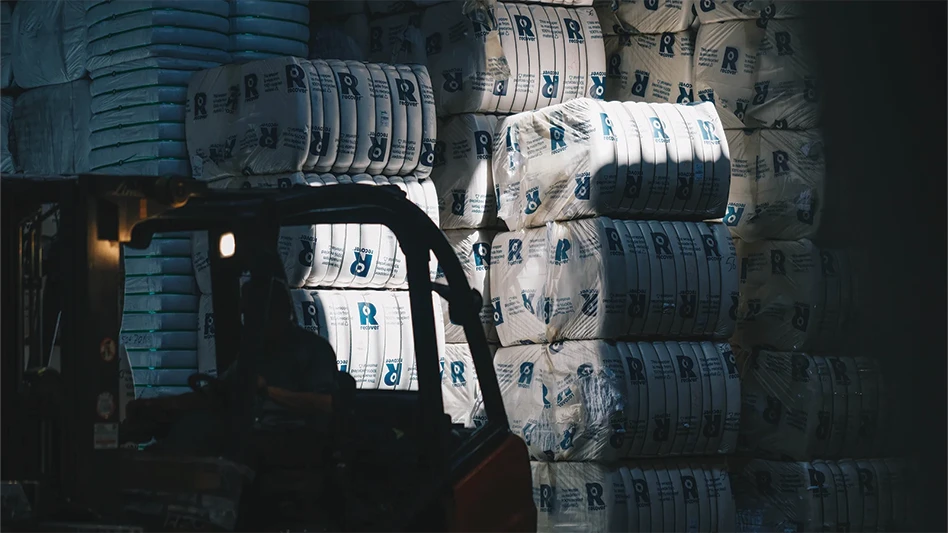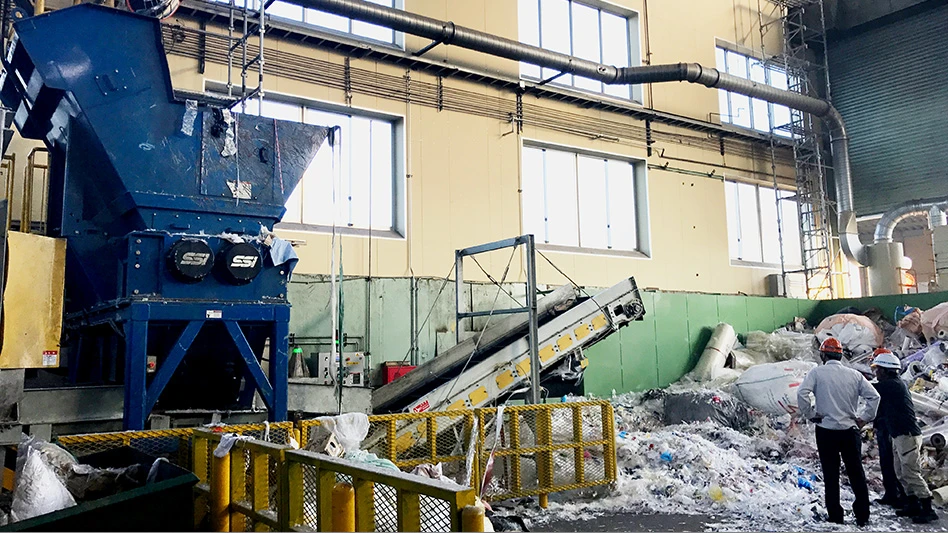
Mark Campbell Productions
Chemical recycling continues to be a controversial topic among industry professionals, both in its potential and its public image. During the 2022 Paper & Plastics Recycling Conference hosted by the Recycling Today Media Group Oct. 19-20 in Chicago, experts discussed obstacles facing chemical recycling and how the industry can overcome them.
“I feel like there's a lot of confusion around the whole chemical recycling landscape,” said session moderator Kim Holmes, principal consultant for 4R Sustainability Inc., an Oregon-based consulting firm specializing in circularity. “It became clear that there needs to be a discussion around how we make people feel more comfortable and accepting of chemical recycling.”
Holmes led the conversation with Laura Thompson, program director of the Recycled Material Standard for GreenBlue, Charlottesville, Virginia; Holli Alexander, strategic initiatives manager for Eastman, Kingsport, Tennessee; and Robert Flores, vice president of sustainability for Berry Global, Evansville, Indiana.
Three obstacles hinder chemical recycling’s image and could potentially limit its growth, the panelists said, including trouble understanding the various terms and processes that go into chemical recycling, its public image and its image with lawmakers.
Flores said people don’t like the term “chemical,” which makes the process sound negative. Confusion and misunderstanding about the process itself also have created pushback from environmental groups like the Natural Resources Defense Council (NRDC), a nonprofit environmental advocacy group based in New York.
Earlier this year, the NRDC accused companies such as Brightmark of “greenwashing” chemical recycling and said the process emits toxic chemicals and greenhouse gases, creating hazardous waste, polluting waterways and burdening nearby communities.
“The most vocal thing is around incineration,” Thompson said. “[Opponents] will say ‘Oh, you're burning plastic, and you're converting fuel to energy.’ We just don't look at it that way. We see it as one of the tools in the toolbox to help advance the circularity of plastics.”
Another obstacle chemical recycling faces is that it’s still a relatively new concept in recycling. Alexander said regulations in place do not have terms like "chemical recycling" that would recognize the process. As a result, this makes it tough for politicians and the general public to understand the process.
“It's complicated right now,” Alexander said. “Historically, mechanical recycling was the only mechanism that we had to recycle these materials.”
The panelists said the primary way the industry can curb these misunderstandings and biases about chemical recycling is by increasing company transparency and community education. By doing so, companies can help communities better understand chemical recycling, its impacts on the environment and how companies are managing any problem materials produced from the process.
Alexander said Eastman commissioned a waste and emissions study of its two chemical recycling processes. "We've really tried to engage deeply into the two different technologies where we're playing so we understand what can happen, and we're doing everything we can to manage to make sure that we're not creating things that are not beneficial, or anything that we do create that will be a contaminant that we can manage it effectively."
Another way to increase transparency is to increase the traceability of the materials destined for chemical recycling. One such method is called mass balance.
"In short, the mass balance process is an accounting process," Thompson said. "[Y]ou just think about balancing your materials in and out and how you're going to account for those downstream claims. It's more like math than science.
According to the American Chemistry Council, a mass balance approach measures the amount of used plastic that enters advanced recycling processes and ensures that claims of recycled content in the resultant product do not exceed that amount. Mass balance has previously been successful in developing high levels of transparency and consumer trust for other materials, such as paper and renewable energy.
“The standards do create that full transparency,” Thompson said. “[It accounts for] when is it allowed, how is it allowed, how is it measured and how is it defined. That's truly the role of the standards. To create that transparency and accountability.”
Panelists also discussed how monitoring the material that goes into the chemical recycling process allows a company to control the stream. If there is material a company is concerned about, it can remove it quickly through efficient material sortation and preparation.
The panelists agreed that companies should increase their efforts to reach out to the communities where they operate facilities. This includes engaging with the community on what the facility does, how it manages materials and what benefits the company provides to the area.
"We have a key focus on making sure that we are a valued member of the community, that we are offering good employment options, [that] we're creating a safe environment for the citizens and our workers,” Alexander said of a recent retrofit Eastman did of an existing gasification asset in Kingsport.
Alexander added that as the company continues to look for additional areas to build methanolysis facilities, Eastman is considering the demographics of those communities. "We're trying to figure out where we can go and put in a facility to make sure that we are not going to create additional burdens on communities that shouldn't have to bear that," she says.
Despite the obstacles in the way of chemical recycling, the panelists agreed that its role will only grow in the future.
“I think we'll continue to see significant growth both on the mechanical side and the advanced recycling side,” Flores said. “So, I think any application where mechanical is suitable, mechanical recycling will be there [and] we'll continue to see that growth. We are [also] seeing more EPR [extended producer responsibility] recycled-content mandates, and I think that'll drive the demand and the growth in the chemical recycling as well as having more of these commercial scale facilities.”
Latest from Recycling Today
- Biden officially blocks Nippon Steel’s acquisition of US Steel
- Highland Sanitation awarded solid waste and recycling contract in Wanamingo, Minnesota
- Ecobat gathers support for California permit renewal
- RecyclX platform designed to provide materials transparency
- Turkish mills sampled wide scrap market in 2024
- GLE Scrap Metal acquires interest in Mallin Cos.
- 2024 marks strong year for Van Dyk
- Recycled metal portrayed as former dictator’s fiefdom





